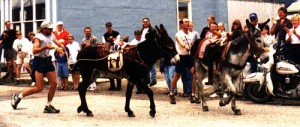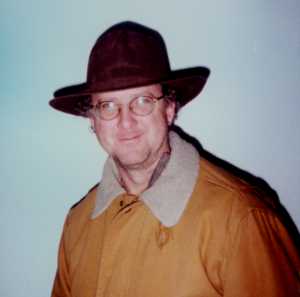Article by Ken Stitzel
Railroads – March 2004 – Colorado Central Magazine
CENTRAL COLORADO is haunted by ghost railroads. Some rails are long gone, but you can drive where the trains once ran: over Marshall Pass in the summer or through the Midland Tunnels on the county road just north of Buena Vista.
You can also see the old railroad beds criss-crossing the landscape from places such as Trout Creek Pass. Snow permitting, you can even hike or cross-country ski on old rail routes, enjoying the easy grade and the broad cindery path, and occasionally even finding a rusty spike or two.
But the Tennessee Pass line in Central Colorado is an odd exception: with intact rails, but no trains. The line runs from Dotsero, just east of Glenwood Canyon, to where active railroading begins again near the Royal Gorge west of Cañon City. It traverses the Eagle Valley, Tennessee Pass, Malta (below Leadville), Buena Vista, and Salida along the way. Once a route for a dozen or more trains every day, carrying everything from coal to iron ore to autos to general merchandise, the Tennessee Pass route lost almost all of its trains in 1997, when the Union Pacific Railroad bought up the rival Southern Pacific Railroad.
The giant UP, the largest railroad in the world, rerouted its through trains to the parallel Moffat Tunnel line from Dotsero to Denver. Local traffic dried up on the Tennessee Pass route with the closing of the last mine in Leadville. Service remains to a wallboard plant at Gypsum, with the hundred-odd miles of track in between seeing only sporadic use as a place to store empty coal cars. (Sightings have also placed a mysterious yellow track speeder on the line from time to time.)
These tracks may eventually be torn up — or they may play host to a new stream of loaded coal trains growling over the continental divide and downhill to the energy hungry Midwest. Which will it be?
UP won’t say. But the railroad rumor mill offers the latest in colorful suggestions.
Trackside busybodies in Grand Junction allege that UP has increased hiring for train crews there. Why? The best guess has it that this is to cover a long-planned bump in the number of coal trains serving the underground mines on the North Fork of the Gunnison River in the Paonia area.
But where will all these new trains go? The Moffat line is near capacity, with up to 23 trains a day, and in February, the railroad announced plans to close the tunnel for several weeks for maintenance. Traffic is supposed to be re-routed north across Wyoming.
With maintenance slowing or closing the busy tracks, more trains, the bottleneck of the six-mile-long Moffat Tunnel, and the usual delays that go with mountain railroading, there isn’t much room to move on the rails. It begins to look as though UP might need the safety valve of Tennessee Pass.
Chaffee County Commissioner Joe De Luca told a workshop on Feb. 11 that the commissioners had heard that train traffic might resume on Tennessee Pass. Asked to amplify, he said “There’s nothing solid. But we’ve heard rumors from three or four different places, so it’s something to keep in mind.”
Yet, other rumors seem to conflict. One old but persistent tale has resurfaced again: that the old rail yard in Minturn — now choice real estate for its proximity to Vail — will be sold to a developer. Because the railroad once used Minturn as a base for adding extra locomotives to push trains over the steep north side of Tennessee Pass, this “yard sale” seems to preclude more trains.
Countering this, however, others suggest that UP could change past operations by adding extra remote-controlled locomotives in Grand Junction to push trains over the pass and then cut the remotes off at Malta to return west with empty coal trains. Another sensible buzz among the railroad cognoscenti has it that UP will only run westbound empty trains over Tennessee Pass, avoiding the need for extra locomotives altogether.
OTHER QUESTIONS REMAIN. The Tennessee Pass line ends in Pueblo — where UP has a connection to Texas, but has sold its former connection to Kansas City. If the Tennessee Pass Line were restored, some figure that UP would cooperate with its main competitor, the Burlington Northern Santa Fe, using its lightly trafficked route east from Pueblo.
One exotic but enduring rumor has UP planning to build a connection from east of Pueblo up to its “Kansas Pacific” route between Denver and Kansas City. Ironically, this would roughly reconstruct the approximate route of the Arkansas Valley Railroad, which became Colorado’s first ghost railroad back in 1877.
Coincidentally or otherwise, this would fit in with a plan recently touted by Colorado Department of Transportation director Tom Norton that would reroute most trains from along the Front Range to the eastern plains. But Norton also places this plan 50 years in the future with no funding — putting this real plan above the realm of rumor but nowhere near likelihood.
Even if UP does decide to reopen, the tracks would take a heap of fixing, with rocks to move, culverts to clear, and signals and track to replace. UP moves hundreds of trains across the western US daily and has many competing priorities. Nothing may happen this year. Nothing may happen at all.
Meanwhile, the tracks lie in repose under the Central Colorado snow, intact but gathering rust, weeds, and fallen rocks.
Ken Stitzel lives in Fort Collins and works as a contractor to the federal government, but he is trying to reform and get honest work. This report was prepared with the assistance of the Tennessee Pass Underground, a dedicated group of railroad fanatics who keep their ears to the rails — figuratively, of course, since the rails are quite cold right now.



